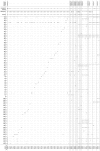Prevalence of HPV 16 and HPV 18 lineages in Galicia, Spain
- PMID: 25111834
- PMCID: PMC4128731
- DOI: 10.1371/journal.pone.0104678
Prevalence of HPV 16 and HPV 18 lineages in Galicia, Spain
Abstract
Genetic variants of human papillomavirus types 16 and 18 (HPV16/18) could differ in their cancer risk. We studied the prevalence and association with high-grade cervical lesions of different HPV16/18 variant lineages in a case-control study including 217 cases (cervical intraepithelial neoplasia grade 2 or grade 3 or worse: CIN2 or CIN3+) and 116 controls (no CIN2 or CIN3+ in two-year follow-up). HPV lineages were determined by sequencing the long control region (LCR) and the E6 gene. Phylogenetic analysis of HPV16 confirmed that isolates clustered into previously described lineages: A (260, 87.5%), B (4, 1.3%), C (8, 2.7%), and D (25, 8.4%). Lineage D/lineage A strains were, respectively, detected in 4/82 control patients, 19/126 CIN3+ cases (OR = 3.1, 95%CI: 1.0-12.9, p = 0.04), 6/1 glandular high-grade lesions (OR = 123, 95%CI: 9.7-5713.6, p<0.0001), and 4/5 invasive lesions (OR = 16.4, 95%CI: 2.2-113.7, p = 0.002). HPV18 clustered in lineages A (32, 88.9%) and B (4, 11.1%). Lineage B/lineage A strains were respectively detected in 1/23 control patients and 2/5 CIN3+ cases (OR = 9.2, 95%CI: 0.4-565.4, p = 0.12). In conclusion, lineages A of HPV16/18 were predominant in Spain. Lineage D of HPV16 was associated with increased risk for CIN3+, glandular high-grade lesions, and invasive lesions compared with lineage A. Lineage B of HPV18 may be associated with increased risk for CIN3+ compared with lineage A, but the association was not significant. Large well-designed studies are needed before the application of HPV lineage detection in clinical settings.
Conflict of interest statement
Figures






Similar articles
-
Genetic diversity of HPV16 and HPV18 in Brazilian patients with invasive cervical cancer.J Med Virol. 2016 Jul;88(7):1279-87. doi: 10.1002/jmv.24458. Epub 2016 Jan 12. J Med Virol. 2016. PMID: 26694554
-
The effectiveness of HPV16 and HPV18 genotyping and cytology with different thresholds for the triage of human papillomavirus-based screening on self-collected samples.PLoS One. 2020 Jun 11;15(6):e0234518. doi: 10.1371/journal.pone.0234518. eCollection 2020. PLoS One. 2020. PMID: 32525936 Free PMC article.
-
Human Papillomavirus 16 Lineage D is Associated with High Risk of Cervical Cancer in the Brazilian Northeast Region.Rev Bras Ginecol Obstet. 2023 Aug;45(8):e474-e479. doi: 10.1055/s-0043-1772180. Epub 2023 Sep 8. Rev Bras Ginecol Obstet. 2023. PMID: 37683659 Free PMC article.
-
Phylogeny and Classification of Human Papillomavirus (HPV)16 and HPV18 Variants Based on E6 and L1 genes in Tunisian Women with Cervical Lesions.Asian Pac J Cancer Prev. 2018 Dec 25;19(12):3361-3366. doi: 10.31557/APJCP.2018.19.12.3361. Asian Pac J Cancer Prev. 2018. PMID: 30583341 Free PMC article.
-
Genetic variations of E6 and long control region of human papillomavirus type 16 from patients with cervical lesion in Liaoning, China.BMC Cancer. 2013 Oct 7;13:459. doi: 10.1186/1471-2407-13-459. BMC Cancer. 2013. PMID: 24099556 Free PMC article.
Cited by
-
Genetic diversity and phylogenetic analysis of HPV 16 & 18 variants isolated from cervical specimens of women in Saudi Arabia.Saudi J Biol Sci. 2019 Feb;26(2):317-324. doi: 10.1016/j.sjbs.2018.05.005. Epub 2018 May 3. Saudi J Biol Sci. 2019. PMID: 31485171 Free PMC article.
-
Whole-Genome Analysis of Human Papillomavirus Type 16 Prevalent in Japanese Women with or without Cervical Lesions.Viruses. 2019 Apr 16;11(4):350. doi: 10.3390/v11040350. Viruses. 2019. PMID: 30995759 Free PMC article.
-
Characterization of Intra-Type Variants of Oncogenic Human Papillomaviruses by Next-Generation Deep Sequencing of the E6/E7 Region.Viruses. 2016 Mar 14;8(3):79. doi: 10.3390/v8030079. Viruses. 2016. PMID: 26985902 Free PMC article.
-
Type distribution of human papillomaviruses in ThinPrep cytology samples and HPV16/18 E6 gene variations in FFPE cervical cancer specimens in Fars province, Iran.Cancer Cell Int. 2023 Aug 11;23(1):166. doi: 10.1186/s12935-023-03011-8. Cancer Cell Int. 2023. PMID: 37568237 Free PMC article.
-
Molecular analysis of human Papillomavirus detected among women positive for cervical lesions by visual inspection with acetic acid/Lugol's iodine (VIA/VILI) in Libreville, Gabon.Infect Agent Cancer. 2016 Sep 7;11(1):50. doi: 10.1186/s13027-016-0098-1. eCollection 2016. Infect Agent Cancer. 2016. PMID: 27610192 Free PMC article.
References
-
- Bouvard V, Baan R, Straif K, Grosse Y, Secretan B, et al. (2009) A review of human carcinogens–Part B: biological agents. Lancet Oncol 10: 321–322. - PubMed
Publication types
MeSH terms
LinkOut - more resources
Full Text Sources
Other Literature Sources

